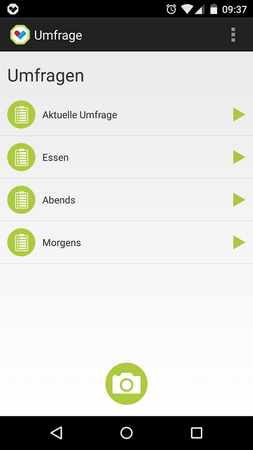Our laboratory
In our laboratory, various measurement tools and analysis methods are used to collect data on stress, emotions such as anxiety, and clinical symptoms. Special computers and software are used to experimentally vary stress- and emotion-inducing stimuli. In addition, new ambulatory measurement methods are used which collect clinical symptoms, stress and emotions in everyday life.
These measurements are performed both in the laboratory and in the ambulatory setting.
Laboratory assessment
The laboratory consists of different psychophysiological measurement facilities (examination & control room, sleep laboratory).
The following psychophysiological functions can be measured in our laboratory:
- Electroencephalography (EEG) using TMSi Refa 72-channel, 4 x TMSi Porti 32-channel, 64-channel Dense Array EEG.
- Electrocardiography (ECG)
- Electrodermal activity (EDA)
- Impedance cardiography (ICG)
- Respiration (thorax and abdomen)
- Facial electromyography (EMG, 3 channels)
- Electrooculography (EOG)
- Sleep EEG (up to 16 channels)
- Polysomnography
- Pulse plethysmography
- Finger temperature
- Motion (up to 2 3D accelerometers)
- pCO2
- Blood pressure (Finapres 2300 and upper arm cuff)
Special recording techniques
- Eye tracker
- Rating dial
- Digital recording of psychophysiological reactions (Polybench)
- Reaction time measurement
- Digital recording of behaviour (incl. emotional facial reactions) with video cameras
- Saliva samples for the collection of neuroendocrinological stress markers and levels of sex hormones
- mobile measuring stations are used for external laboratory implementations for testing patient populations in clinics
- functional magnetic resonance imaging (fMRI) in the scanner of the Center for Neurocognitive Research (CNCR)
Special stimulus techniques
- Stress- and emotion-triggering films, images, and sounds
- Exposure therapy in 3D virtual reality
- Eye-blink startle
- Classical conditioning
- Biofeedback
- Trier Social Stress Test (TSST)
- Olfactometry
- Programming of stimulus presentation using E-Prime
- Electrical stimuli
- Transcranial direct current stimulation (tDCS)
- Neuroendocrine stimulation (especially cortisol and oxytocin)
Analytical methods
- ANSLAB (integrated program package for the analysis of psychophysiological data; developed in our laboratory)
- Heart rate variability
- Brain Vision Analyzer
- SPSS
- MPlus
- MATLAB
- Language Inquiry and Word Count (LIWC)
For more information on our lab please visit the homepage of the Federal Ministry of Science, Research and Economy.
Ambulatory assessment
Ambulatory assessment is the systematic collection of psychological and/or physiological data under everyday conditions (at work, at school, during leisure time).
Ambulatory monitoring means the monitoring of physiological functions of freely moving persons under everyday conditions as opposed to stationary “wired” monitoring in the laboratory. Ambulatory monitoring can be done either by radio systems or by digital portable measurement systems.
The following technologies are used in our projects:
Electronical diaries
In collaboration with the Puch University of Applied Sciences, we developed our own software for smartphones (Android, iOS) (PsyDiary).
Electronic diaries are used for the timely collection of psychological data in everyday life. Data collection almost immediately following the event takes into account the influences of different contexts and of different moods. Collecting data in the familiar environment leads to improved ecological validity. The immediate collection of data reduces retrospective bias in contrast to subsequently submitted questionnaires or conducted interviews, where the answering of questions depends on memory, time interval to the symptom, and momentary mood. In general, subject compliance and data quality are higher with electronic diaries than with paper/pencil questionnaires.
Actigraphy
An actigraph (other names: actimeter, actometer) is a small device worn like a wristwatch that detects movement through a piezoelectric sensor. We use devices from camntech (MotionWatch).
An actigraph contains a microprocessor and a memory, which is able to store the movement data during several days and weeks. After the measurement, this data can be transferred to a computer via an interface and analyzed there with special software. This enables, for example, the detection of sleep and wake phases and various objective parameters of sleep quality.
Psychophysiological ambulatory monitoring
Depending on the field of application we use different ambulatory monitoring systems: Variolab, Vitaport-1, Vitaport-3, VarioPort-B. These allow recording objective physiological markers of, e.g., stress, anxiety and other emotions in everyday life. In addition, they allow specialized measurements, e.g., polysomnography at home or chewing detection over several days.
PsyDiary

Actigraph (MotionWatch)

Ambulatory recording device (VarioPort)

